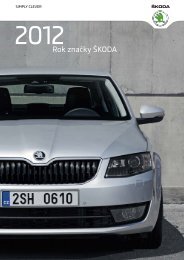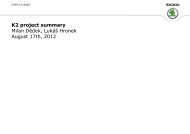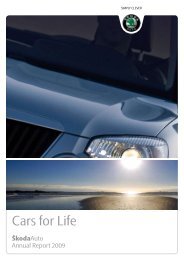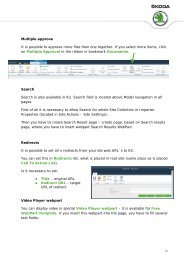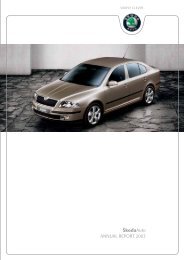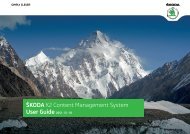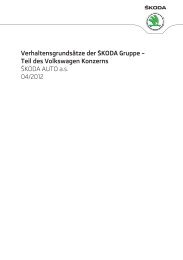Å kodaAuto ANNUAL REPORT 2006 - Skoda Auto
Å kodaAuto ANNUAL REPORT 2006 - Skoda Auto
Å kodaAuto ANNUAL REPORT 2006 - Skoda Auto
You also want an ePaper? Increase the reach of your titles
YUMPU automatically turns print PDFs into web optimized ePapers that Google loves.
1.5 Property, plant and equipment<br />
All property, plant and equipment are stated at historical cost less depreciation and – where necessary – write-downs for impairment.<br />
Historical cost includes expenditure that is directly attributable to the acquisition of the items.<br />
All repairs and maintenance costs, as well as interest paid, are charged to the income statement during the financial period in which they<br />
are incurred. Subsequent costs are included in the asset’s carrying amount or recognised as a separate asset, as appropriate, only when it is<br />
probable that future economic benefits associated with the item will flow to the Company and the cost of the item can be measured<br />
reliably.<br />
Land is not depreciated. Depreciation of other assets is calculated using the straight-line method over its estimated useful life, as follows:<br />
– Buildings 10–50 years<br />
– Technical equipment and machinery (incl. special tools) 2–18 years<br />
– Other equipment, operating and office equipment 3–15 years<br />
Government grants related to purchase of tangible assets are deducted in order to arrive at the carrying amount of the relevant tangible<br />
asset.<br />
1.6 Impairment of assets<br />
Assets that are subject to amortisation and depreciation are reviewed for impairment whenever events or changes in circumstances<br />
indicate that the carrying amount may not be recoverable. An impairment loss is recognised for the amount by which the asset’s carrying<br />
amount exceeds its recoverable amount. The recoverable amount is the higher of an asset’s fair value less costs to sell and value in use.<br />
For the purposes of assessing impairment, assets are grouped at the lowest levels for which there are separately identifiable cash flows<br />
(cash-generating units).<br />
1.7 Financial Assets<br />
The Company classifies its financial assets in the following categories: financial assets at fair value through profit or loss; loans and<br />
receivables; held-to-maturity investments; available-for-sale financial assets; and shares in subsidiaries and associates. The classification<br />
depends on the purpose for which the financial assets were acquired. Management determines the classification of its financial assets at<br />
initial recognition and re-evaluates this designation at every reporting date.<br />
(a) Financial assets at fair value through profit or loss<br />
Financial assets at fair value through profit or loss are financial assets held for trading. A financial asset is classified in this category if<br />
acquired principally for the purpose of selling in the short term or if so designated by management. Derivatives are also categorised as<br />
held for trading unless they are designated as hedging instruments. Assets in this category are classified as current assets.<br />
(b) Loans and receivables<br />
Loans and receivables are non-derivative financial assets with fixed or determinable payments that are not quoted in an active market.<br />
They arise when the Company provides money, goods or services directly to a debtor with no intention of trading the receivable. They are<br />
included in current assets, except for maturities greater than 12 months after the balance sheet date. These are classified as non-current<br />
assets. Loans and receivables are classified as trade receivables, or other receivables and financial assets in the balance sheet (Note 7 and<br />
Note 9).<br />
104







